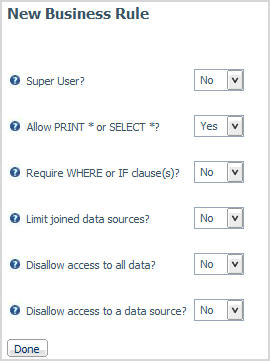The left pane of the main Resource Management screen
contains the Business Rules Folder, a tool that allows you to create
BRL statements accurately and quickly using a dialog box that will
generate rule syntax for you, and a plain text editing facility
where you can customize the rules.
For additional information about building rules with BRL, see Business Rule Language (BRL).
x
Procedure: How to Create New Business Rules
-
Launch the
iWay Web Console.
-
Click the Resource Management option
on the toolbar.
-
Right-click Business
Rules in the navigation pane and select New.
-
The New
Business Rule pane opens, as shown in the following image.

Make any desired changes
and click Done to save them and create rule
syntax. For additional information on this pane, see New Business Rule Pane.
x
Procedure: How to Check for Syntax Errors
You
can verify BRL syntax at any point while building rules by saving
the rule(s) in the editor.
-
Click the Save As
 button.
button.
The Save As dialog box appears.
-
Type a name and click Save.
If there are no syntax errors, control is returned to the
editor window with the rule text. If there are errors, a dialog
displays error message(s).
-
Click OK and control is returned to
the editor with the rule text. The rule text is saved.
-
Make corrections as needed and repeat the verification process
until no errors are found.
x
Reference: New Business Rule Pane
The following
image shows the New Business Rule pane.

The New Business Rule
pane has the following options:
-
Super User?
-
A user ID that is entered into the rules that will be allowed
to execute any request that may be canceled by the governor under
normal operating. A user ID may be up to 48 characters in length.
Selecting Yes from the drop-down menu will
open a text field for the user ID input.
-
Allow PRINT * or SELECT *?
-
This setting allows the user to set whether or not a rule
will be written. If Yes is selected, a rule
will not be created and a SELECT or PRINT * may be used at any time
in a data request. If No is selected, a rule
will be written disallowing the condition regardless of any other
rules in the source. The default value is Yes.
-
Require WHERE or IF clause(s)?
-
This setting allows you to specify the number, and name,
of a condition.
-
How Many? Allows you to specify that a certain number
of conditions or relational clauses are required on a data request.
Values can be 0-256. The default value is 0.
-
With a particular name. Allows
you to require a specific field name.
-
Limit joined data sources?
-
The number of data sources used in the request. The limit
is 16 and the default value is 0, or No. Selecting Yes will
open a text field for input.
-
Disallow access to all data?
-
Allows you to specify a time of day when data reporting is
not allowed. The times are based on a 24 hour clock. The values
allowed are 0000-2359.
-
Disallow access to a particular data source?
-
Allows you to disable a data source name from reporting availability.

 button.
button.